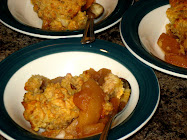Not being one to waste such an opportunity, I spent Friday doing absolutely nothing. Well, I went to the gym while it snowed. Then went out to eat. And then I came home and sat on my couch through about 6 hours of mostly-crappy movies. The couch had sucked me in, though, and I couldn't escape.
Sunday, The Best Friend came over for lunch and about 9 hours of almost do-nothing-ness. Except for one thing: we were idly paging through cookbooks and found a recipe for focaccia bread. Which we agreed that we had to make immediately. And by "we had to make" I mean "she drank wine and watched me knead dough".
From start to finish it took a couple of hours. But dinner that night was some wonderful focaccia bread, stuffed with feta and oregano, topped with kosher salt and rosemary. It was ok the next night heated up with dinner, but this is one bread that must be eaten straight from the oven. Which will burn off half of your taste buds, but the remaining ones are so happy, that they gladly survive the sacrifice.

Stuffed Focaccia
Original recipe - which I didn't follow much past the actual dough - from "Bread" by Eric Treuille.
Ingredients:
For the dough:
- 2 tsp dry yeast
- 1 1/4 cups water
- 3 1/2 cups bread flour
- 1 1/2 tsp salt
- olive oil
- 8? oz feta, crumbled
- small handful of fresh oregano
- 4 Tbsp? olive oil
- 1 tsp? kosher salt
- 2 Tbsp? fresh rosemary
First, the dough:
Dissolve the yeast in warm water and let stand for five minutes. The original recipe called for 2 tsp of yeast, but mine was kind of on the old side so I used 3 - which was unnecessary, as this made it rise higher than real focaccia bread should rise. So you can go ahead and kick me out of the "Real Focaccia Bread Makers" club.
Put the flour in a large bowl and combine with the salt. Make a well in the middle, pour the yeast/water in the center and stir with a wooden spoon - I ended up using my hands - until combined.
Flour your kneading surface, and knead for about 5 minutes, until it's elastic-y.
Place in an oiled bowl, turning to coat, cover it with a warm cloth and let rise until doubled. I turned my oven on while I was mixing the dough; when the dough was done, I turned it off and set it on top of the stove, so mine rose in about 30 minutes. Is this cheating? I don't care.
Punch the dough down and divide into 2 equal pieces. Chafe* for 5 minutes, then let it alone for a bout 10.
Roll one piece of dough out - I'm supposed to give measurements, but I didn't take any. I just went on the fly. The recipe says "9 1/2 inch rounds", but mine was more oblong and I just eyeballed it.
Sprinkle the cheese crumbles over the dough - I probably used between 8 & 10 ounces of a block of feta, crumbled up.
Sprinkle fresh oregano leaves over the whole she-bang. Again, no measurements, I just kept pulling oregano leaves off the stems until I thought it looked good.

Roll out the 2nd round to a shape as close as possible to the first, and lay over the top.
Preheat your oven to 400.
Use your finger to make many, many indentations across the surface of the dough, about 1/2 inch deep - this was the step the Best Friend handled, while I stripped rosemary stems.
Poke pieces of rosemary into the top of the dough. When I was eating it, I thought the rosemary was the one of the best parts and wished we had put more on it.
Sprinkle the olive oil across the top of the dough. I probably used more than 4 tablespoons - we wanted to make sure a little got in every indentation.

Sprinkle the kosher salt across the top.
Bake at 400 for about 40-45 minutes, or until golden brown across the top. Eat while still warm and gooey in the middle.

Notes: Chafing dough: *"to gently turn the risen ball of dough tucking in the lower edge as you go. Turn the dough around fully three or four times. What this does is pull the top of the dough out, and pushes it in at the bottom. If done right it essentially pulls the dough around in on itself to even things out." -- from here.
I didn't do a whole lot of measuring on this one, because measuring fresh herbs for this would have been a pain, and I would have had to remove the wine glass from one hand. The amounts in the ingredients list is what's listed in the original recipe, although I used some different cheese and herbs. I think I could have definitely used more oregano, a little more feta and maybe some more rosemary. But that might have resulted in a bread so awesome that I would spend the rest of my life eating it...so maybe it's a good thing I didn't go overboard.












